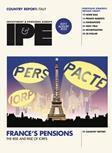Two major Swiss unions have agreed with the association for employer representatives on a reform package for the law governing second pillar pensions.
One of the most long-awaited and urgent steps is the immediate reduction of the minimum conversion rate in the second pillar from 6.8% to 6%. This rate is used to calculate annual pension payouts.
However, the cut – along with other proposals – will have to be put into legal form by the government, enter a consultation phase and then pass parliament. It is not yet clear whether there will be a public referendum on the proposal.
Previous major votes in 2010 and 2017 on cutting the conversion rate as part of wider reforms did not achieve the necessary majority from the public.
As part of the proposal, the union federation SGB/USS, the union Travail.Suisse, and the employer association SAV/UPS called on the government to aim for the new legal framework to come into effect by 2021 or 2022 at the latest.
Swiss pension experts have long called for a cut to the minimum conversion rate that has to be applied to calculate pension payments from assets accrued in the mandatory part of the second pillar.
It is widely agreed that the current 6.8% level is too high, which has resulted in cross-financing of pensions from active members’ assets.
Those pension funds representing employers paying more than the mandatory minimum contribution have already taken drastic steps to lower the conversion rate, with some cutting it to below 5%.
Having “diligently negotiated” a compromise that was “to the point and holds weight”, the unions and employer representatives were confident that it would “find a majority” in parliament.
Other changes put forward
Other proposed legal amendments included a top-up payment on second pillar pensions for the next 15 generations of new retirees from the time the revised law – known as BVG/LPP – took effect.
This was meant to ensure that any sudden cut in the conversion rate did not cause some generations to suffer greater losses.
Money for this measure was to come from a minor top-up to first-pillar contributions made by employers.
The proposal also included a slight reduction in the legal minimum contribution for employees to the second pillar, particularly for employees over 45, making it “cheaper” for an employer to keep older employees.
Thumbs up from ASIP
The Swiss pension fund association ASIP welcomed the agreement as it showed that employer representatives and unions “were aware of the urgency” of reforming the BVG/LPP.
However, it said in a press release that it would “assess the proposed measures without prejudice” over the coming months.
One measure that would “have to be tested for its practicability” was the additional top-up payments for second-pillar pension retirees coming from first-pillar contributions. ASIP said it wanted to assess the proposal’s effects on the pension funds that have to implement it.
The pension fund association called on the government to “quickly” start the consultation phase on revising the BVG/LPP law.
Further reading
In need of a reformist zeal
The Swiss pension system needs reform but consent is needed in a federal referendum. Have politicians learnt from campaigning during the rejected Altervorsorge 2020 proposals?
Goodbye AV2020
A no vote in the referendum on pensions seemed like a ‘what if’ thought experiment right up until the ballot. But on the last Sunday in September 2017, the Swiss voted against reforms to the first and second pillar in the Altersvorsorge 2020 legislative package












No comments yet